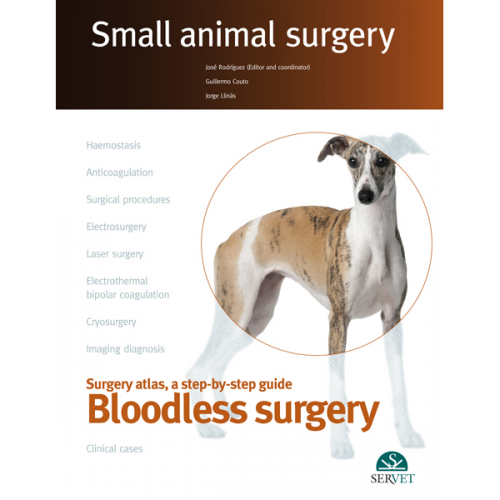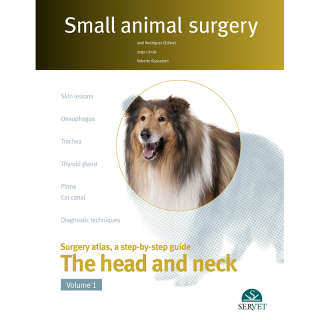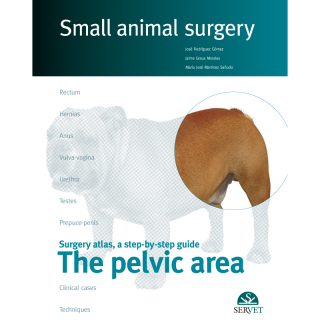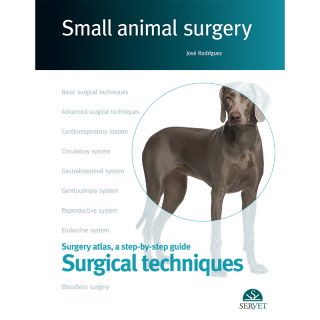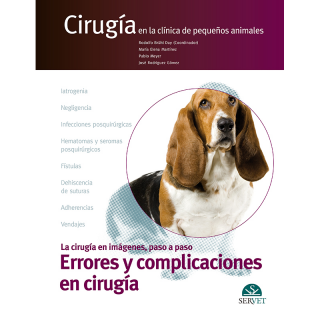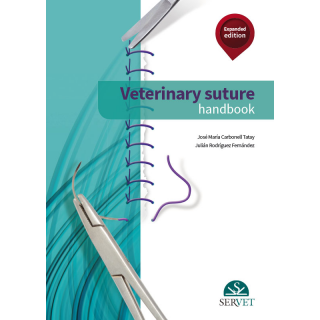Envío gratuito en compras superiores a 19€ (Península y Baleares)
José Rodríguez, together with Guillermo Couto and Jorge Llinás, surprises us again with a new volume of the Small Animal Surgery collection, although this time he focuses on the application of bloodless surgery. The author and his colleagues use their wide experience to show readers the importance of ensuring appropriate haemostasis in surgical procedures. The basic principles of haemostasis, their practical application in various clinical cases or the different techniques available are explained throughout the book, and the information is complemented by numerous images that will help the clinician to ensure haemostasis (making knots step by step, surgical procedures shown in sequences of images, etc.). This work also stands out by including high-quality and very didactic videos, with which the reader will be able to gain valuable knowledge.
1. Introduction
2. Haemostasis and haemostatic disorders
Physiology of haemostasis for clinicians
Clinical signs in haemorrhagic syndromes
Techniques for the evaluation of haemostasis
Platelet count
Buccal mucosal bleeding time
Laboratory tests
Preoperative evaluation of haemostasis
Care of patients with coagulopathies or preoperative haemorrhages
Common coagulopathies in veterinary practice
Primary haemostatic disorders
Secondary haemostatic disorders
Mixed haemostatic disorders
3. Anticoagulation and fibrinolysis
Introduction
Thromboembolic diseases
Antiplatelet drugs, anticoagulants and fibrinolytics
Antiplatelet drugs
Anticoagulants
Fibrinolytics
4. Principles of blood transfusion
Introduction
Indications
Blood types
Blood typing
Blood administration
Complications of transfusion therapy
Crossmatching
5. Anaesthesia and perioperative bleeding
Introduction
Factors involved
Patient position
Mechanical ventilation
Changes in patient ventilation
Effects of anaesthetic drugs
Phenothiazines
Benzodiazepines
α2 agonists
Opiates
Ketamine
Propofol
Alphaxalone
Sodium thiopental
Etomidate
Inhaled anaesthetics
Anticholinergics
Non-depolarising neuromuscular blocking drugs
Non-steroid anti-inflammatory drugs
Fluid therapy
Crystalloids
Colloids
Local and regional anaesthesia
Local infiltration with local anaesthetic and/or adrenaline
Epidural anaesthesia
Intravenous regional anaesthesia (Bier block)
Hypothermia
Behaviour of anaesthetic agents incasesof hypothermia
Acidosis
Anaesthetic techniques thatminimise bleeding
Controlled hypotension
Permissive hypotension or hypotensive resuscitation
Acute normovolaemic haemodilution
Acute hypervolaemic haemodilution
6. Preoperative haemostatic techniques
Systemic prohaemostatic drugs
Lysine analogues
Ethamsylate
Other treatments
Supportive haemostatic treatments
Acupuncture
Homoeopathy
7. Intraoperative haemostasis techniques
Techniques for minimising blood loss during surgery
Preventative haemostasis
Hydrodissection
Ligatures
Vascular clamps and Rummel tourniquet
Haemostatic clips. Surgical staplers
Clinical applications in hepatic, splenic and pulmonary surgery
Definitive haemostasis
Haemostasis by compression
Topical haemostatic agents
Surgical haemostatic techniques
Haemostatic forceps
Ligatures
Technique
Sutures
Estimated intraoperative blood loss
Subjective method
Gravimetric method
Other methods
8. High energy surgical equipment
Introduction
Electrosurgery
Key concepts of electricity
Characteristics of the currents generated by an electrosurgical unit
How tissue responds to the passage of electricity
Safety in electrosurgery
Electrosurgical equipment and electrodes
Laser surgery
Basic principles
Laser in veterinary surgery
Basic elements of laser systems
Temporal output mode
Choice of laser
Interaction of laser with tissue
Tips for optimising the use of laser in surgery
Other systems
Electrothermal bipolar coagulation
Personal safety
Smoke
Risks and precautions in laser surgery
9. Cryotherapy and cryosurgery
Local hypothermia. Cryotherapy
Cryosurgery
Advantages and disadvantages of cryosurgery
Cryogenic agents
Liquid nitrogen
Nitrous oxide
Dimethyl ether and propane
Cryogenic agent application techniques
Application by pulverisation
Application by tube (contact terminal)
Application with swabs
Warnings and postoperative care
10.Postoperative bleeding
Introduction
Causes of bleeding
Assessment of bleeding severity
Treatment
Initial treatment
Evolution of postoperative bleeding
Diagnosis and ultrasound monitoring ofpostoperative bleeding
11. Applicationsandsurgicalcasestudies
Maxillofacial surgery
Surgical case study/Premaxillectomy
Ophthalmic surgery
Surgical case study/Hotz-Celsus blepharoplasty with CO2 laser
Ear surgery
Surgical case study/Ablation of the external ear canal
Penile surgery
Surgical case study/Partial amputation of the penis
Hepatic surgery
Surgical case study/Hepaticlobectomy
Adrenalgl and surgery
Surgical case study/Adrenalectomy
Adrenalectomy in ferrets
Cardiovascular surgery
Surgical case study/Thoracoscopic pericardiectomy
Surgical case study/Tetralogy of Fallot
Perianal fistulae
Surgical case study/Perianal fistulae resection
Brachycephalic syndrome
Widening of nostrils
Palatoplasty
Excision of laryngeal saccules
12. References
- Autor/es Guillermo Couto, Jorge Llinás, José Rodríguez Gómez
- Fecha de edición diciembre 2013
- Nº Páginas 288
- Encuadernación Tapa dura
- Tamaño 23 X 29'7
- Idioma Inglés

